-

人教版高中英语必修1Anne's best friend说课稿
Step 7 Language points 1.Vocabulary (1) go through (2) set down (3) a series of (4) on purpose (5) in order to (6)at dusk (7)entirely (8)face to face 2.Important sentences (1)…I’ve grown so crazy about everything to do with nature. (2)There was a time when … (3)I stayed awake on purpose until … (4)It was the first time … that I’d seen the night … (5)It’s no pleasure looking through … Purpose: 1.Master the required vocabulary and sentence structures. 2.Use them freely. Step 8 Consolidation 1.Find out the topic sentences 2.Retell the text according to the topic sentences Purpose: I want to know if my students understand the text. Step 9 Discussion Imagine you have to go into hiding like Anne and her family, what would you miss most? Giveyour reasons. Purpose: Train Ss’ oral English ability. Step 10 Homework Write an article on Friends. Purpose: 1. Improve the Ss’ writing ability. 2 Train the Ss’ ability of self—teaching and looking up information by themselves. Part 5 Blackboard design(说板书设计)Unit 1 Friendship Reading Anne’s Best Friend 1.Main idea of each paragraph: Para. 1 Anne made her diary her best friend. Para .2 Anne wrote her feelings in her diary. Para .3 Anne missed nature. Para.4 Anne saw the night face to face Para.5 Anne wanted to experience nature outdoors. 2.Listening: Exx.1 P3 3.Discussion: Exx.3 P3 Purpose: 1.Make Ss familiar with the passage 2.Make the design inductive, instructive and artistic.

人教版高中英语必修1English around the world说课稿
(3)v. 给:提出;展现,显现present sb. with sth. ; present sth. to sb. 把. . 交给;颁发;授予present sth. (for sth. )/present sth. to sb. e. g. Om his birthday, his friends presented him a collection of stamps. 在他生日时,他的朋友们送给他一套邮票作为礼物。The sword was presented by the family to the museum. 这家人把宝剑捐赠给了博物馆。The committee will present the final report to Parliament in June. 委员会将在六月向议会提交最后的报告。You need to present yourself better. 你需要更善于展现自己。It is essential that we present a united front. 至关重要的是我们要表现得更加团结。Step 4 ConsolidationT:Now that we have got a general idea of these words and phrases. Lets make up some sentences using them to master them. Suggested sentences:1. Your duties include typing letters and answering the telephone. 2. It is one of the greatest roles that she has played. 3. A large number of people have applied for the job. 4. The number of the panda is declining. 5. I'11 go there, even if I have to walk. 6. He came up to me to ask for a light. 7. The novel is about a family who can't communicate with each other. 8. He based his plan on interests of most people. 9. Why doesn't he make use of his singing talent?Step 5 Summary and homeworkT:Today we dealt with several new words and phrases. After class I hope that youcan read them again and again to keep them in mind. That's all for today. You aredismissed.

人教版高中英语必修4Women of achievement说课稿4篇
Good morning, distinguished judges:It’s my honor to talk about my teaching ideas with you. Today my topic is Women of Achievement. My presentation consists of six parts: the analysis of teaching material and student, teaching aims, key and difficult points, teaching and studying method, teaching procedures and blackboard design.First, let’s focus on the analysis of teaching material. This lesson is from New Senior English for China Student’s Book 4 Unit 1, the reading part. The main topic of the passage is the introduction of a student of Africanwildlife. After this lesson, the students will learn more information about her studying chimps in Africa, and their reading and speaking abilities can be developed as well.The next part is the analysis of students. My students are in senior high students. They have learnt English for many years, they’ve known many words and sentences, but their speaking and reading abilities are still not very good. So I will practice their speaking and reading abilities through different exercises.According to the New Standard Curriculum and the present situation, I set the teaching aims as follows: firstly, knowledge aims. Students can grasp some new words, such as worthwhile, move off. Moreover, students can understand the content of the passage and get familiar with the topic of studying chimps in wildlife. Secondly, ability aims. Students can use reading strategies such as skimming and scanning in reading process. Thirdly, emotional aims. Students can have the awareness of protecting animals and care about animals.Based on the above analysis, the key point of this lesson is to get the main idea and the detailed information from the passage; the difficult point is to talk about the wildlife protection and use reading strategies.

人教版高中英语必修3Festivals around the World说课稿3篇
Teaching plan for Unit 1 book3Good morning, teachers. It’s my great pleasure to be here because I can share my lesson with you and I can learn a lot from it. I’ll begin my lesson from the following four parts, the teaching material, the teaching methods, the studying methods and the teaching procedure.Firstly, let me talk about the teaching material. The content of my lesson is the reading passage festivals and celebrations of Unit 1 Festivals around the world. This passage is about festivals and celebrations. By studying this passage, we’ll enable the students to know that festivals exit everywhere, and many of festivals in different countries celebrate similar ideas. As we all know, the reading passage is the center of each unit. If the Ss can learn it well, it will be helpful to make the Ss learn the rest of this unit.After studying the teaching material, I think the teaching aims are as the followings:1. Knowledge aims:(1) The Ss can master the usage of the important words andexpressions.(2)The Ss can use the __________________ (grammar) in the proper situation.Make students know about the festivals all over the world and the detail of the festivals, such as origin, content, and the date of the holiday festivals.2. Ability aims:(1) Students can talk about festivals and celebrations in English(2) To improve the student’s reading ability, especially their skimming and scanning ability.3. Emotion aims:Make the Ss know about the foreign festivals, and respect other countries’ custom.Next, let’s come to the important points and the difficult points.The important point is how to make the Ss understand the text better and the difficult point is how can they talk about it. secondly, Teaching Methods:1. task-based Language Teaching2. Computer assisted language teaching.3. question-and–answer methodThirdly, Studying Methods:

人教版高中英语必修5Great scientists说课稿4篇
通过写文章梗概,培养学生综合运用语言的能力,学习用恰当的英语描述科学家的故事。这是本课的教学难点。教师可以使用完形填空的方式来帮助学生整理语篇,从而来降低难度。本课的教学重点的突破方法是:在阅读前,让学生初步了解得出科学观点所需要的基本程序,从而轻松而自然地导入文章的阅读;在阅读过程中,由易到难设计快速阅读和精读的问题,层层推进各种阅读活动,让学生对阅读内容从整体感知到细节理解,最后深层读懂整篇文章,同时加强阅读策略的指导,让每个学生都主动参与课堂教学活动,最终达到提高阅读能力的目的。Step 4 Post-readingGroup Activities四人小组共同合作,在老师的适当指导下,就以下2个问题展开讨论,让学生就所知、所学、所感和所想融入话题,然后抽若干同学代表作小组发言。1. What do you think about John Snow, and what should we learn from him?2. Cholera was 19th century disease, which two diseases are similar to cholera today? Why?
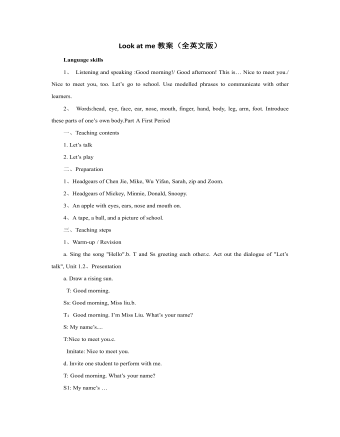
人教版新课标PEP小学英语三年级上册Look at me教案(全英文版)
3、Practicea. Nice to meet you. Nice to meet you,too.b. Perform the dialogue.c. Arrange the dialogue according to the pictures or sentence cards.d. Let’s play.A: Good afternoon,B. This is C. Hello, C! Nice to meet you.C: Nice to meet you, too.A,B: Goodbye!C: Bye!4、Assessment Workbook page 10Add-activitiesa. Listen to the recording and repeat.b. Make a dialogue according to "Let’s talk".Second Period一、Teaching contents1. Let’s learn Words:body, leg, arm, hand, finger, foot.1. Let’s do二、Preparation1、a puppet2、Cards of body, leg, arm, hand, finger and foot.3、headgear of a captain三、Teaching steps1、Warm-up/ Revisiona. Captain says to review "let’s do" of Part A.b. Perform the students their own dialogues.2、Presentationa. Learn to say "body, leg, arm, hand, finger and foot."b. Listen to the recording and repeat.c. Let’s do. Clap your hands. Snap your fingers. Wave your arms. Cross your legs. Shake your body. Stamp your foot.3、Practicea. Let’s draw a person.b. Let’s do. Point out which picture.c. Let’s do. Who responses faster.4、Assessment Workbook page 115、Add-activitiesa. Listen to the recording, repeat and act out.b. Say all the names of the body to your parents.Third Period一、Teaching contents1. Let’s check2. Let’s chant二、Preparation1、stationeries1、pictures of parts of Zoom
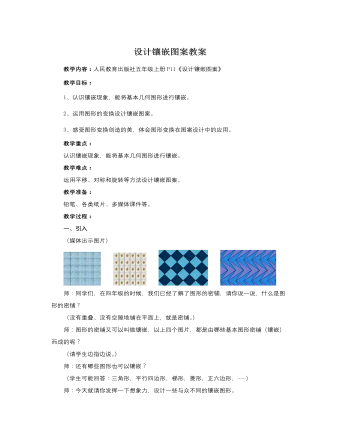
人教版新课标小学数学五年级下册设计镶嵌图案教案
师:同学们,在四年级的时候,我们已经了解了图形的密铺,请你说一说,什么是图形的密铺?(没有重叠、没有空隙地铺在平面上,就是密铺。)师:图形的密铺又可以叫做镶嵌,以上四个图片,都是由哪些基本图形密铺(镶嵌)而成的呢?(请学生边指边说。)师:还有哪些图形也可以镶嵌?(学生可能回答:三角形,平行四边形,梯形,菱形,正六边形,……)师:今天就请你发挥一下想象力,设计一些与众不同的镶嵌图形。[设计意图说明:学生在四年级已经初步了解了图形的密铺(镶嵌)现象,四幅图片是四年级下册教材《三角形》单元中《密铺》内容中的原图。本单元在此基础上,通过数学游戏拓展镶嵌图形的范围,让学生用图形变换设计镶嵌图案,进一步感受图形变换带来的美感以及在生活中的应用。]二、新授探究一:利用平移变换设计镶嵌图形
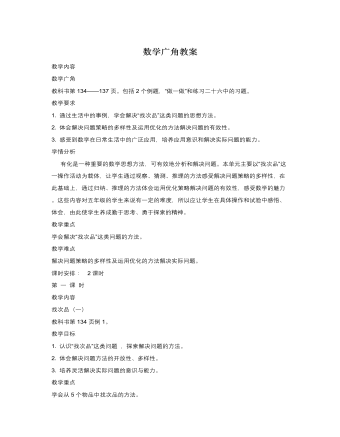
人教版新课标小学数学五年级下册数学广角教案
教学要求1. 通过生活中的事例,学会解决“找次品”这类问题的思想方法。2. 体会解决问题策略的多样性及运用优化的方法解决问题的有效性。3. 感受到数学在日常生活中的广泛应用,培养应用意识和解决实际问题的能力。学情分析有化是一种重要的数学思想方法,可有效地分析和解决问题。本单元主要以“找次品”这一操作活动为载体,让学生通过观察、猜测、推理的方法感受解决问题策略的多样性,在此基础上,通过归纳、推理的方法体会运用优化策略解决问题的有效性,感受数学的魅力。这些内容对五年级的学生来说有一定的难度,所以应让学生在具体操作和试验中感悟、体会,由此使学生养成勤于思考、勇于探索的精神。教学重点学会解决“找次品”这类问题的方法。
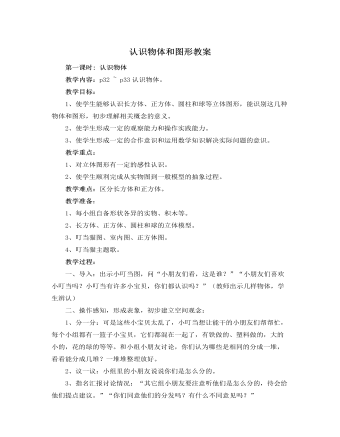
人教版新课标小学数学一年级上册认识物体和图形教案
1.让学生拿出长方体摸一摸,问:你有什么感觉?摸的的面是什么形状?师:谁来摸一摸,老师手上长方体的长方形在哪?(学生找出长方形)2.让学生在自己的学具(长方体、正方体、圆柱体)上找图形,并和小组里的同学说一说。3、指名说,教师把学生找到的图形从立体图形上分离出来,贴于黑板上,师:这些图形是物体上的一个面,这就是我们今天要认识的图形。(板书课题——认识平面图形)4.让学生说说:从什么物体上找到了什么图形?5.师:你能想办法把这些形状画到一张纸上吗?请学生演示各自不同的方法,然后教师在黑板上沿长方体的一个面画出长方形。师:你会画吗?请小朋友们用自己喜欢的办法画出并剪出长方形、正方形、圆和三角形各2个。
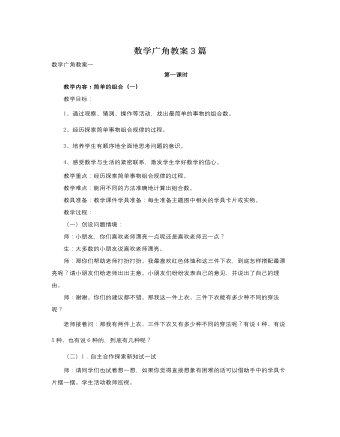
人教版新课标小学数学三年级上册数学广角教案3篇
(一)创设问题情境:师:小朋友,你们喜欢老师漂亮一点呢还是喜欢老师丑一点?生:大多数的小朋友说喜欢老师漂亮。师:那你们帮助老师打扮打扮。我最喜欢红色体恤和这三件下衣,到底怎样搭配最漂亮呢?请小朋友们给老师出出主意。小朋友们纷纷发表自己的意见,并说出了自己的理由。师:谢谢。你们的建议都不错。那我这一件上衣、三件下衣能有多少种不同的穿法呢?老师接着问:那我有两件上衣、三件下衣又有多少种不同的穿法呢?有说4种、有说5种、也有说6种的,到底有几种呢?(二)1.自主合作探索新知试一试师:请同学们也试着想一想,如果你觉得直接想象有困难的话可以借助手中的学具卡片摆一摆。学生活动教师巡视。2.发现问题学生汇报所写个数,教师根据巡视的情况重点展示几份,引导学生发现问题:有的重复了,有的漏写了。
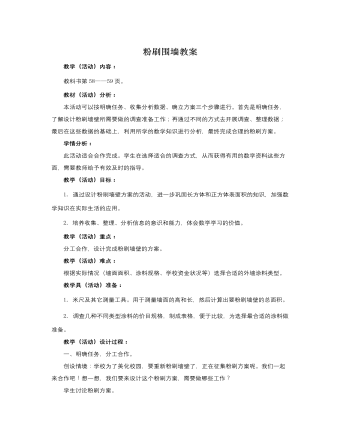
人教版新课标小学数学五年级下册粉刷围墙教案
(3)按每千克涂料粉刷3.5 m2计算,可求出共需要涂料:1600÷3.5≈460(千克);(4)根据涂料的型号及费用,选择合适的涂料。师:选择涂料时,要考虑很多因素,如价格、耐用期、消费心理、环保等,要怎么选择呢?学生可以把几种涂料进行对比,一起讨论决定,同时学会在交流中理解接纳别人较好的建议:如:A型,优点:价格便宜,需要19桶,总共才5700元;缺点:耐用期太短,两年后又要重新粉刷;B-1型和B-2型,虽然桶装量不同,但价格和耐用期都处在中游水平;C型和D型,优点:耐用期长,最划算;缺点:价格太高,不符合人们的消费心理,也不可能持续那么长时间,至少5年就要更换一下样子。综合以上价格、耐用期、消费心理,选择B-1或B-2型比较划算。而这两种比较来看,B-2型更便宜一些,所以,最后确立用B-2型涂料。

人教版新课标小学数学五年级下册因数与倍数教案
因此,本套教材中删去了“整除”的数学化定义,而是借助整除的模式na=b直接引出因数和倍数的概念。在本册教材中,由于允许学生采用多样的方法求最大公因数和最小公倍数,分解质因数也失去了其不可或缺的作用,同时,也是为了减少这一单元的理论概念,教材不再把它作为正式教学内容,而是作为一个补充知识,安排在“你知道吗?”中进行介绍。由于这部分内容较为抽象,很难结合生活实例或具体情境来进行教学,学生理解起来有一定的难度。在过去的教学中,一些教师往往忽视概念的本质,而是让学生死记硬背相关概念或结论,学生无法理清各概念间的前后承接关系,达不到融会贯通的程度。再加上有些教师在考核时使用一些偏题、难题,导致学生在学习这部分知识时觉得枯燥乏味,体会不到初等数论的抽象性、严密性和逻辑性,感受不到数学的魅力。所以在教学中应注意以下两点: (1)加强对概念间相互关系的梳理,引导学生从本质上理解概念,避免死记硬背。(2)由于本单元知识特有的抽象性,教学时要注意培养学生的抽象思维能力。
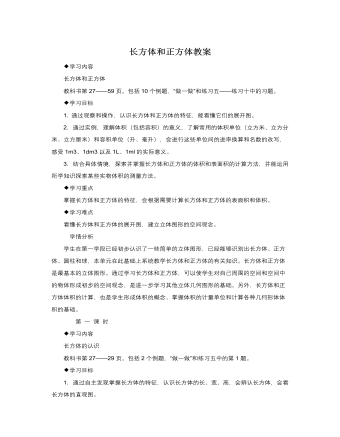
人教版新课标小学数学五年级下册长方体和正方体教案
◆学习内容长方体和正方体的体积教科书第40——43页例1、例2,第43页“做一做”,以及练习七第3——8题。◆学习目标1. 掌握长方体和正方体的体积计算公式,学会计算长方体和正方体的体积。2. 培养实际操作能力,推理能力及运用知识解决实际问题的能力。◆学习重点能正确计算长方体和正方体的体积。长方体和正方体体积的计算是形成体积的概念、掌握体积的计量单位和计算各种几何形体体积的基础。◆学习难点理解长方体和正方体的体积计算公式的推导过程。体积公式的推导是建立在充分的感性经验的基础上,沟通每行个数、行数、层数与长、宽、高之间的联系,进而顺理成章地推导出公式。◆学习过程1. 实验探索长方体的体积公式计量一个长方体的体积是多少,就是看这个长方体里含有多少个体积单位。但不是所有的物体都能切割成若干个小正方体。动手做试验:用体积为1cm3小正方体摆成不同的长方体。将相关数据填入下表。
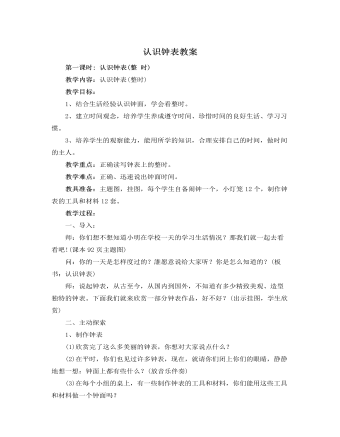
人教版新课标小学数学一年级上册认识钟表教案
二、认识半时1、挂图出示钟面:7时半、8时半师:请小朋友拿出自己的钟,拨一拨这二个钟面上所表示的时刻,你能发现这两个钟面有什么共同的特点吗?2、学生自由回答。教师小结,得出规律:钟面上半时时,分针指着数字6,而时针总是指向两个数字的中间。挂图再出示二个钟面上的表示的时刻,师:你说一说这两个钟面的时刻是多少3、认一认挂图出示图片(即书中第93面的做一做)师:请你说一说图中的小朋友,几时在干什么?4、挂图出示7时、7时半师:请你们认真观察,说一说这两个钟面上表示的时刻,看一看两根指针的位置有什么不同?5、教师小结。三、练习反馈,激活思维1、请你在你的钟上面拨一个你最喜欢的半点时刻,并说一说你为什么最喜欢这个时刻?
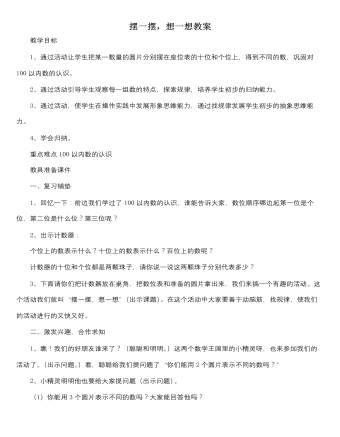
人教版新课标小学数学一年级下册摆一摆,想一想教案
每组4名小朋友3名在数位板上摆圆片,1名小朋友对摆出的结果进行综合、记录。3、全班一起用2个圆片摆出不同的数,引导学生讨论一下问题:(1)为什么两个圆片摆在个位上得到的数十2,而摆在十位上得到的数十20?(2)记录摆出的数是需要注意什么?(3)怎样才能知道摆出的数不遗漏?4、从刚才小朋友们用圆片摆数的过程,你发现有没有规律?下面我们不摆圆片,能不能在脑子里想摆圆片的方法,直接写出6个圆片,7个圆片,8个圆片,9个圆片都能表示哪些数?好,四个人合作,看哪一组填写的又快又好!学生分组活动:分别用3、4、5、6、7、8、9个圆片摆出不同的数。5、从以上我们所摆的圆片个数和写出来的数来看,同学们观察到有什么规律了吗?谁能说一说。
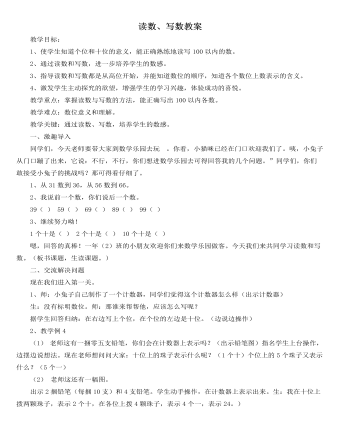
人教版新课标小学数学一年级下册读数、写数教案
教学目标:1、使学生知道个位和十位的意义,能正确熟练地读写100以内的数。2、通过读数和写数,进一步培养学生的数感。3、指导读数和写数都是从高位开始,并能知道数位的顺序,知道各个数位上数表示的含义。4、激发学生主动探究的欲望,增强学生的学习兴趣,体验成功的喜悦。教学重点:掌握读数与写数的方法,能正确写出100以内各数。教学难点:数位意义和理解。教学关键:通过读数、写数,培养学生的数感。一、激趣导入同学们,今天老师要带大家到数学乐园去玩 。你看,小猫咪已经在门口欢迎我们了。咦,小兔子从门口蹦了出来,它说:不行,不行,你们想进数学乐园去可得回答我的几个问题。”同学们,你们敢接受小兔子的挑战吗?那可得看仔细了。1、从31数到36,从56数到66。2、我说前一个数,你们说后一个数。

人教版新课标小学数学一年级下册整十数加、减整十数教案
二、讲授新课(一)看图引入1、(课件)大家看这幅主体图,图上都有什么?还有什么?2、你能估计一下,这里大概有多少盆花吗?大概有多少盆黄花?多少盆红花?你是怎么知道的?3、小结:我们数花的数量的时候,可以一盆一盆的数,也可以10盆10盆的数,还可以5盆5盆的数,怎样方便怎样数。今天我们开始学习100以内的加法和减法,首先学习整十数加、减整十数。板书课题:整十数加、减整十数2、教学例1。(1)整十数加整十数。教师:请同学们按要求摆小棒。(请一名学生到前面摆,其余学生在课桌上摆)左边摆一捆小棒,每捆十根,表示红花的盆数。右边摆两捆两捆小棒,表示黄花的盆数。教师:一捆小棒表示多少?又摆两捆小棒表示什么意思?教师:要求红花和黄花一共有多少盆,怎样列式?(10 + 20 )接着教师指导学生进行口算的思考过程:① 10是几个十?20是几个十?
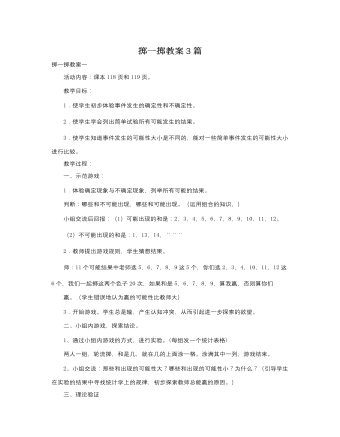
人教版新课标小学数学三年级上册掷一掷教案3篇
3、开始游戏。学生总是输,产生认知冲突,从而引起进一步探索的欲望。(二)小组内游戏,探索结论。通过小组内游戏的方式,进行实验,利用统计的方式呈现实验的结果,初步探索教师总能赢的原因。要引导学生在实验的结果中寻找统计学上的规律。(三)理论验证通过组合的理论来验证实验的结果。可以用不同的方式来进行组合,让学生探讨每个“和”所包含的组合情况的多少与这个“和”出现的次数之间的关系。三、师生共同小结本次活动1、通过本次活动,你有什么新的收获?2、师生总结:本次活动通过猜想、实验、验证等过程,让同学们在问题情境中自主探索,解决问题,既发展了同学们的动手实践能力,又充分调动了同学们的学习兴趣。
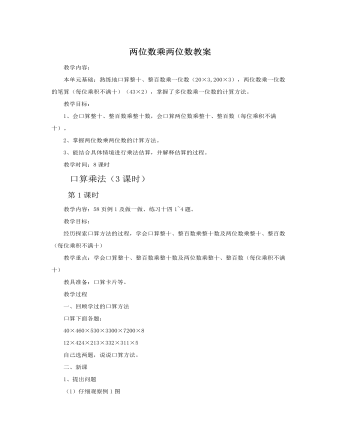
人教版新课标小学数学三年级下册两位数乘两位数教案
(1)学生笔算。(2)请学生观察比较:上行的题目和下行的题目有什么异同?(3)学生讨论交流:它们的计算方法是一样的,不同的是上行的题目计算时没有进位,而下一行的题目需要进位。(4)说说笔算乘法要注意什么?4、正误辩析:教师用小黑板出示6道计算出现错误的笔算式题,让学生判断正误,并进行改正。二、解决问题:1、完成练习十六第3题:(1)引导学生看图,获取信息。(2)同桌互相说:把图上的意思完整的说一说。(3)独立列出算式,并用竖式笔算。(4)集体讲评。2、学生独立完成练习十五第4题、第8题。第8题:在解决这道题时,是不是所有的信息都用上?为什么“每套12张”用不上?这样的题目给了你什么启示?三、综合练习:独立完成练习十六第5、6、7题。四、学习总结:说说这节课有什么收获?笔算乘法要注意什么?
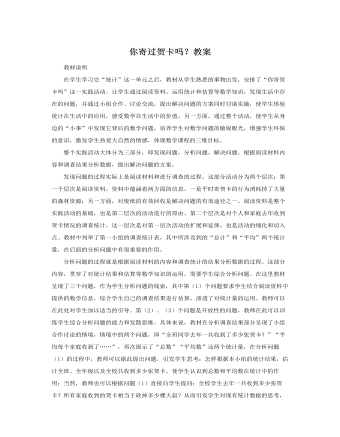
人教版新课标小学数学四年级上册你寄过贺卡吗?教案
整个实践活动大体分为三部分,即发现问题,分析问题,解决问题。根据阅读材料内容和调查结果分析数据,提出解决问题的方案。发现问题的过程实际上是阅读材料和进行调查的过程。这部分活动分为两个层次:第一个层次是阅读资料。资料中蕴涵着两方面的信息,一是平时寄贺卡的行为消耗掉了大量的森林资源;另一方面,对废纸的有效回收是解决问题的有效途径之一。阅读资料是整个实践活动的基础,也是第二层次的活动进行的原由。第二个层次是对个人和家庭去年收到贺卡情况的调查统计,这一层次是对第一层次活动的扩展和延伸,也是活动的细化和切入点。教材中列举了第一小组的调查统计表,其中所涉及到的“总计”和“平均”两个统计量,在后面的分析问题中有很重要的作用。分析问题的过程就是根据阅读材料的内容和调查统计的结果分析数据的过程。这部分内容,贯穿了对统计结果和估算等数学知识的运用,需要学生综合分析问题。